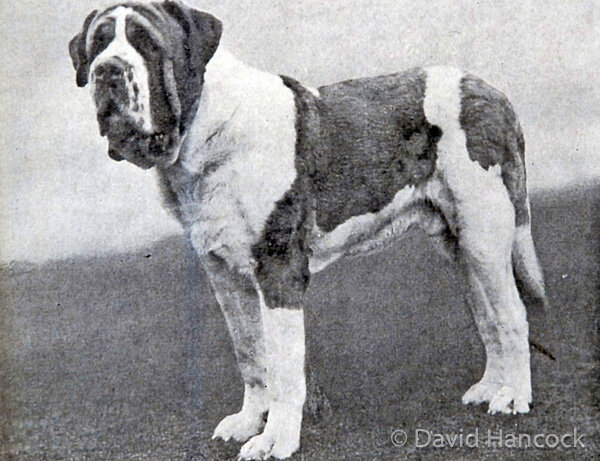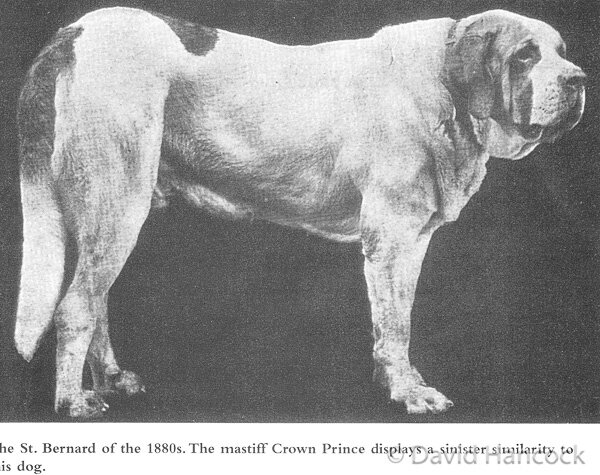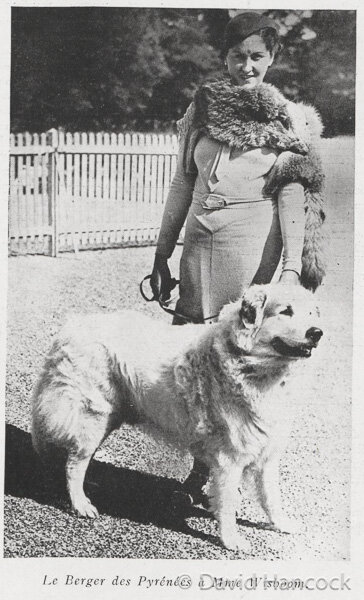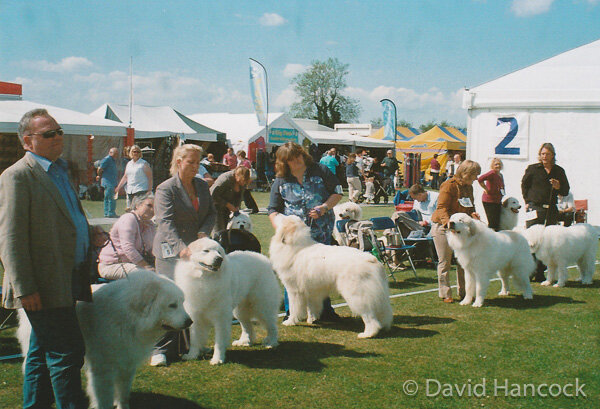1194
MOUNTAIN DOGS REMOULDED
By David Hancock
The large powerful impressive-looking dogs used to protect sheep over many centuries have moved from the high pastures to the show-ring and the pet category but not without loss to themselves. In north-western Europe, for example, two breeds of mountain dog stand out as having undergone distinct changes to their form and type. In the Alps, the flock-protector became the snow-rescue dogs employed by the monks at the St Bernard hospice, originally dubbed Alpine ‘Mastiffs’, sometimes as Gotthard dogs but better named Alpine Mountain Dogs. Once they became St Bernards in name their form moved away from the mountain dog type and became less pastoral dog and more show dog and pet. A comparable transition befell the Pyrenean Mountain Dog, although they continued to be employed both in the pastures of southern Europe and in America and Africa as classic flock protectors or Livestock Protection Dogs (LPDs). The criteria once used to shape the Alpine dog have long been dropped; the Pyrenean Mountain Dog is also threatened by a change in type, as the show-ring makes its mark.
Powerful dogs bred to protect livestock have been utilized from the upland areas of Iberia in the west, right across to Iran and on to the highlands of Eastern Europe, from mountainous Balkan regions in the south and northwards to former Soviet states. Some were called shepherd dogs, others mountain dogs and a few dubbed 'mastiffs', despite the more precise use of that word in modern times. Their coat colours can vary from solid white to dark-grey and from a rich russet to solid black, often with tan. Many that developed as breeds are no longer used as herd-protectors and their numbers in north-west Europe seriously declined when the use of draught dogs became a victim of the mechanized age. A number of shared features connect these far-flung types: a dense weatherproof jacket, a substantial build, an impressive magnanimity and a strong protective instinct to guard livestock placed under their supervision. As a group, they would be most accurately described as the flock guardians; in Britain in the distant past they were referred to as 'shepherd's mastiffs', but they were valued all over Europe, especially in mountainous areas - as found in south-western France, northern Portugal and Spain, central Italy and the Alps of Switzerland.
This manifests itself in the resultant distribution of such big herd-protectors: the Maremma of Italy, the Estrela Mountain Dog and Cao Rafeiro do Alentjo of Portugal, the Kuvasz of Hungary, the Pyrenean Mountain Dog and its sister breed, the Pyrenean Mastiff, the Tatra Mountain Dog of Poland, the Rumanian sheepdog, the Sar Planina of Yugoslavia, the Transcaucasian Owtcharka and the Kuvasz of Slovakia. These modern breeds may have developed separately over the last thousand years but the similarities are all too obvious. Local preferences have manifested themselves, with black and tan dogs being favoured in northern Switzerland, southern Germany and in the Beauce area of France and the red and white of the St Bernard in the south, more like the big dogs of the Pyrenees, the Abruzzi and the Greek and Yugoslavian mountain areas. Time and time again you will find writers on these breeds linking them with an origin from the Tibetan Mastiff. But I believe all such big mountain dogs or shepherd dogs share a common origin and came south with migrating people, ending up in the Pyrenees, the Alps, the Balkans and the foothills of the Himalayas.
It disappoints me therefore to see the St Bernard being bred more like a mastiff than a mountain dog. Historically, the hospice dogs were much more like the other mountain breeds and did not feature the massive head, loose lips, deep stop and excessive dewlaps of the modern pedigree St Bernard. I can never see the rationale in extolling the proud history of a breed and then perpetuating that breed in a different mould. Huge dogs have a magnanimity, a munificence and a majesty all of their own and simply don't need exaggeration to promote themselves or win our admiration. Sadly too the St Bernard has lost its working role and seems to be bred for bulk rather than activity. Every depiction of a Hospice dog shows a strapping active dog, lacking carthorse bone and drooling lips. No dog with slobbering lips would last long in sub-zero temperatures.
Nowadays, the mountain rescue services of the Alpine nations make great use of dogs, nearly always German Shepherd Dogs, dogs thankfully rated on what they can do not on physical beauty. We all love a handsome dog but must be careful we don't end up with just mindless, role-less pet-dogs with no purpose or inspiration to influence breed design. If the breed of St Bernard were to be bred like a 'transhumance' breed in the mountain dog mould, the soundness and indeed the historical accuracy of the breed would be greatly enhanced. Transhumance dogs had to spend months in the high summer pastures - deterring wolves and human threats - move livestock immense distances or across perilous mountain passes, needing the size to impose themselves and survive harsh conditions, a weatherproof coat to keep out a wide range of temperatures and really sound feet to withstand the daily wear on them. Drooling lips, sagging eyelids and surplus bulk does such a breed no favours.
The breed histories of the other mountain dogs, like the Pyrenean breeds, contrast starkly with the sheer nonsense written about the St Bernard down the years. And what a pity that is, for the St Bernard is a truly magnificent breed, full of virtue and worthy of our admiration. The St Bernard really doesn't need wildly-exaggerated stories about its prowess in the snow-rescue field. The facts indicate that the role of the hospice-dog was to prevent travellers getting lost in deep snow, rather than rescue them with brandy and blankets. The monks had no fixed ideas on breeding, resorting to outside blood of other breeds and never having success in rearing puppies at the hospice, needing to send whelping bitches down to the valley.
The monks sold or gave away the very large pups and those with long coats. Yet the short-coated variety has never had the acclaim of the longer-coated version. Wynn, in his History of the Mastiff, states that at one stage the monks obtained dogs that were probably identical with those which defended flocks in the Abruzzi mountains. The legendary Barry was a medium-sized short-coated dog. Herr Schumacher has written that around 1830 the monks had to resort to Newfoundland and Great Dane bitches to produce more robust offspring. From 1835 to 1845, huge "Alpine mastiffs" were often recorded and even drawn by Landseer. A dog called L'Ami was exhibited in 1829 as the largest dog in England and as an ‘Alpine mastiff’ but was probably a cropped-eared Great Dane. Many of the St Bernards imported into Britain from 1860 were described as "coming from the Monastery of St Bernard" but most of them were merely descendents of dogs which had been bred there years before. "Idstone" refers to an outcross to a Pyrenean 'wolfhound' (perhaps the Spanish breed of Pyrenean Mastiff) when the hospice kennels were stricken with distemper. The exaggerated claims of hero-feats, by such as the Rev MacDona, led to the breed becoming much admired (with his dog ‘Tell’ a great winner) - with the early dog shows being well-populated with it.
Looking at contemporary St Bernards I suspect that the show-breeders who developed the breed in Britain towards the end of the last century resorted to mastiff blood to produce the desired massiveness and powerful head and obtain extra stature in the breed. There were specimens exhibited then showing distinct signs of blood from huge but totally-unsound Mastiffs like ‘Crown Prince’. This is perhaps now coming through in excess and the St. Bernard has become very different from every other breed of dog from the mountainous areas of the western world. But whether true to their ancestor-stock or not, the big dog from Switzerland has captured our hearts with its gracious grandeur, considerable handsomeness and long-acknowledged qualities as a companion-dog. The Mount St Bernard dog deserves to be regarded and bred as a mountain dog - possessing the anatomy to support that testing role. Looking at the Pyrenean Mountain Dog I can detect a comparable move away from function and into an amended type.
In 2011, the fanciers of the Pyrenean Mountain Dog issued a, brief but quite excellent, well-illustrated brochure on their breed, to be valued because of its remarkable honesty and as an admirable example to other breed fanciers whose breed has similarly lost its way. In this brochure, they argue that true type and the sheer essence of the Pyrenean is being lost in the British show ring. They emphasize that the show ring must not promote selection on the basis of fashion and exaggeration. They considered that fashion was winning over true type, mainly through judges who have never learned or who have just lost sight of the breed’s original purpose. They point out that over the years, the handsome, working, ‘rustique’ dog has been steadily replaced by a glamorous, over-coated and back-combed dog. They remind fellow fanciers that any dog able to work on high, exposed mountainsides must have a lean and muscular build and a weatherproof coat, and they end with a plea for them to respect the ‘dog of the mountains’. I salute them for this publication and applaud their criticism of judges who resort, in their after-show critiques, to words such as ‘cobby’ and ‘upstanding’ that simply do not reflect the Breed Standard for the breed.
The ease of modern living has led to our devaluing the contribution made throughout human history by such flock protectors, but our ancestors prized them and developed them as highly impressive, extraordinarily robust, canine specimens. We must be careful with the surviving breeds not to substitute show-ring criteria for functional need. Huge cow-hocked, straight-stifled, over-coated, under-muscled shepherd's mastiffs would not have lasted long in the demanding pastures of past centuries. Our respect both for our rural heritage and those breeds surviving man's changing requirements needs to be demonstrated by a seeking of soundness before ‘stance’ and fitness ahead of flashiness. These quite remarkable faithful, selfless, admirable dogs, often killed by marauding packs of predatory wolves, deserve no less. With around 330 sheep currently being killed annually by bears, reintroduced from the Czech Republic into the Pyrenees, perhaps the reintroduction too of the shepherd’s mastiff, more determined than the mountain dogs, would be timely. The value of breeds like the Pyrenean Mountain Dog used to be widely accepted but now, perhaps understandably, their use and value has altered in an increasingly urban world. Wherever sheep needed guarding - they were there!
It is forgiveable to believe that such breeds are sizeable because they need to be able to see off wild animals that prey on sheep. But much more important are the bigger stride afforded by size, the ability to carry more fat reserves and store more heat than a small dog and to survive disease, severe weather and the odd accident - big bones break less easily than tiny ones. This is why such breeds possess a similar phenotype; the Estrela Mountain Dog is easily confused with a Slovenian Karst or Caucasian Owtcharka, or a Maremma with a Tatra Mountain Dog. The Caucasian Owtcharka can resemble the early St Bernards, the Alpine flock guardian, too. The shepherds, drovers, stockmen and traders in such dogs knew what made a dog effective and therefore more valuable. It is wrong however to breed for great size alone in such breeds, dogs on long migrations were 60lbs weight not the 100lbs+ often desired in breeds like the St Bernard and the Newfoundland, that suffer badly in extreme heat. The warmer the migration route the lighter the dogs had to be to cope with the temperature. The more substantial dogs – with heftier frames, able to conserve heat – featured further north or purely in mountainous regions.
Over 600 St Bernards but only 108 Pyrenean Mountain Dogs were newly registered in Britain in 2015, compared, say, to 27 Maremma Sheepdogs and 9 Estrela Mountain Dogs and only 3 Anatolian Shepherd Dogs; this type of dog isn't thriving in the show ring and its fanciers are going to have to work hard to conserve such admirable dogs with such a magnificent record of service to man - usually in remote and challenging regions. Such dogs have had much of their protective nature 'bred out' but still care for their owners, and especially their children, in a quite magnanimous manner. They bring a natural dignity, considerable canine handsomeness, a stable predictable temperament and a certain grandeur into our lives. As an estate guard-dog, the Pyrenean Mountain Dog would bring deterrence without overt aggression, a sense of demonstrating their 'ownership' of their family's territory - if not the family itself! But whatever the designated role of the St Bernard and the Pyrenean Mountain Dog, both do not need the pursuit of giant size ahead of soundness, heavy overcoats, poor construction, especially in the hindquarters, or to become a suburban trophy for humans to show off. They deserve to be bred as true mountain dogs: sizeable but not too vast for their own well-being, physically sound without exaggeration and friendly without losing their natural suspicion of strangers. If they are truly bred like a mountain dog in type and temperament, then their future will become much more assured. These really are breeds worth saving but ideally in their working form not an alien one inflicted by fanciers who just do not respect heritage.



























